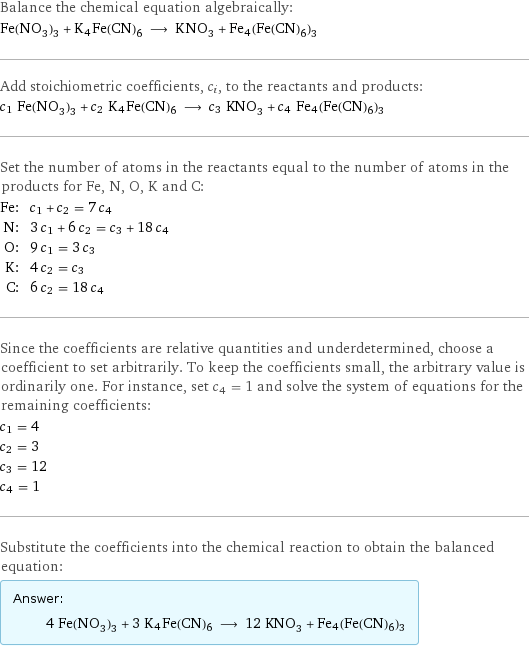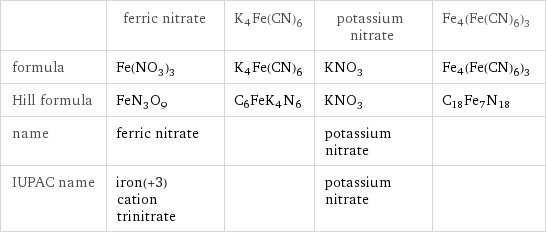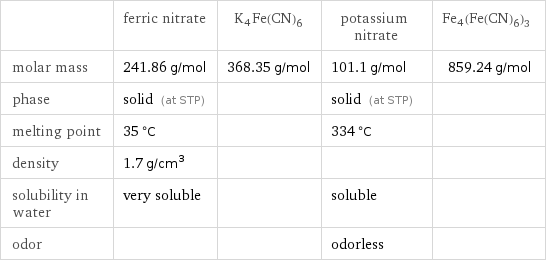Input interpretation

Fe(NO_3)_3 ferric nitrate + K4Fe(CN)6 ⟶ KNO_3 potassium nitrate + Fe4(Fe(CN)6)3
Balanced equation

Balance the chemical equation algebraically: Fe(NO_3)_3 + K4Fe(CN)6 ⟶ KNO_3 + Fe4(Fe(CN)6)3 Add stoichiometric coefficients, c_i, to the reactants and products: c_1 Fe(NO_3)_3 + c_2 K4Fe(CN)6 ⟶ c_3 KNO_3 + c_4 Fe4(Fe(CN)6)3 Set the number of atoms in the reactants equal to the number of atoms in the products for Fe, N, O, K and C: Fe: | c_1 + c_2 = 7 c_4 N: | 3 c_1 + 6 c_2 = c_3 + 18 c_4 O: | 9 c_1 = 3 c_3 K: | 4 c_2 = c_3 C: | 6 c_2 = 18 c_4 Since the coefficients are relative quantities and underdetermined, choose a coefficient to set arbitrarily. To keep the coefficients small, the arbitrary value is ordinarily one. For instance, set c_4 = 1 and solve the system of equations for the remaining coefficients: c_1 = 4 c_2 = 3 c_3 = 12 c_4 = 1 Substitute the coefficients into the chemical reaction to obtain the balanced equation: Answer: | | 4 Fe(NO_3)_3 + 3 K4Fe(CN)6 ⟶ 12 KNO_3 + Fe4(Fe(CN)6)3
Structures

+ K4Fe(CN)6 ⟶ + Fe4(Fe(CN)6)3
Names

ferric nitrate + K4Fe(CN)6 ⟶ potassium nitrate + Fe4(Fe(CN)6)3
Equilibrium constant
![Construct the equilibrium constant, K, expression for: Fe(NO_3)_3 + K4Fe(CN)6 ⟶ KNO_3 + Fe4(Fe(CN)6)3 Plan: • Balance the chemical equation. • Determine the stoichiometric numbers. • Assemble the activity expression for each chemical species. • Use the activity expressions to build the equilibrium constant expression. Write the balanced chemical equation: 4 Fe(NO_3)_3 + 3 K4Fe(CN)6 ⟶ 12 KNO_3 + Fe4(Fe(CN)6)3 Assign stoichiometric numbers, ν_i, using the stoichiometric coefficients, c_i, from the balanced chemical equation in the following manner: ν_i = -c_i for reactants and ν_i = c_i for products: chemical species | c_i | ν_i Fe(NO_3)_3 | 4 | -4 K4Fe(CN)6 | 3 | -3 KNO_3 | 12 | 12 Fe4(Fe(CN)6)3 | 1 | 1 Assemble the activity expressions accounting for the state of matter and ν_i: chemical species | c_i | ν_i | activity expression Fe(NO_3)_3 | 4 | -4 | ([Fe(NO3)3])^(-4) K4Fe(CN)6 | 3 | -3 | ([K4Fe(CN)6])^(-3) KNO_3 | 12 | 12 | ([KNO3])^12 Fe4(Fe(CN)6)3 | 1 | 1 | [Fe4(Fe(CN)6)3] The equilibrium constant symbol in the concentration basis is: K_c Mulitply the activity expressions to arrive at the K_c expression: Answer: | | K_c = ([Fe(NO3)3])^(-4) ([K4Fe(CN)6])^(-3) ([KNO3])^12 [Fe4(Fe(CN)6)3] = (([KNO3])^12 [Fe4(Fe(CN)6)3])/(([Fe(NO3)3])^4 ([K4Fe(CN)6])^3)](../image_source/c1bc648011e9ac18c9b7ffa008e25385.png)
Construct the equilibrium constant, K, expression for: Fe(NO_3)_3 + K4Fe(CN)6 ⟶ KNO_3 + Fe4(Fe(CN)6)3 Plan: • Balance the chemical equation. • Determine the stoichiometric numbers. • Assemble the activity expression for each chemical species. • Use the activity expressions to build the equilibrium constant expression. Write the balanced chemical equation: 4 Fe(NO_3)_3 + 3 K4Fe(CN)6 ⟶ 12 KNO_3 + Fe4(Fe(CN)6)3 Assign stoichiometric numbers, ν_i, using the stoichiometric coefficients, c_i, from the balanced chemical equation in the following manner: ν_i = -c_i for reactants and ν_i = c_i for products: chemical species | c_i | ν_i Fe(NO_3)_3 | 4 | -4 K4Fe(CN)6 | 3 | -3 KNO_3 | 12 | 12 Fe4(Fe(CN)6)3 | 1 | 1 Assemble the activity expressions accounting for the state of matter and ν_i: chemical species | c_i | ν_i | activity expression Fe(NO_3)_3 | 4 | -4 | ([Fe(NO3)3])^(-4) K4Fe(CN)6 | 3 | -3 | ([K4Fe(CN)6])^(-3) KNO_3 | 12 | 12 | ([KNO3])^12 Fe4(Fe(CN)6)3 | 1 | 1 | [Fe4(Fe(CN)6)3] The equilibrium constant symbol in the concentration basis is: K_c Mulitply the activity expressions to arrive at the K_c expression: Answer: | | K_c = ([Fe(NO3)3])^(-4) ([K4Fe(CN)6])^(-3) ([KNO3])^12 [Fe4(Fe(CN)6)3] = (([KNO3])^12 [Fe4(Fe(CN)6)3])/(([Fe(NO3)3])^4 ([K4Fe(CN)6])^3)
Rate of reaction
![Construct the rate of reaction expression for: Fe(NO_3)_3 + K4Fe(CN)6 ⟶ KNO_3 + Fe4(Fe(CN)6)3 Plan: • Balance the chemical equation. • Determine the stoichiometric numbers. • Assemble the rate term for each chemical species. • Write the rate of reaction expression. Write the balanced chemical equation: 4 Fe(NO_3)_3 + 3 K4Fe(CN)6 ⟶ 12 KNO_3 + Fe4(Fe(CN)6)3 Assign stoichiometric numbers, ν_i, using the stoichiometric coefficients, c_i, from the balanced chemical equation in the following manner: ν_i = -c_i for reactants and ν_i = c_i for products: chemical species | c_i | ν_i Fe(NO_3)_3 | 4 | -4 K4Fe(CN)6 | 3 | -3 KNO_3 | 12 | 12 Fe4(Fe(CN)6)3 | 1 | 1 The rate term for each chemical species, B_i, is 1/ν_i(Δ[B_i])/(Δt) where [B_i] is the amount concentration and t is time: chemical species | c_i | ν_i | rate term Fe(NO_3)_3 | 4 | -4 | -1/4 (Δ[Fe(NO3)3])/(Δt) K4Fe(CN)6 | 3 | -3 | -1/3 (Δ[K4Fe(CN)6])/(Δt) KNO_3 | 12 | 12 | 1/12 (Δ[KNO3])/(Δt) Fe4(Fe(CN)6)3 | 1 | 1 | (Δ[Fe4(Fe(CN)6)3])/(Δt) (for infinitesimal rate of change, replace Δ with d) Set the rate terms equal to each other to arrive at the rate expression: Answer: | | rate = -1/4 (Δ[Fe(NO3)3])/(Δt) = -1/3 (Δ[K4Fe(CN)6])/(Δt) = 1/12 (Δ[KNO3])/(Δt) = (Δ[Fe4(Fe(CN)6)3])/(Δt) (assuming constant volume and no accumulation of intermediates or side products)](../image_source/c1b9d962e980c8774c7a8144aa4fccf6.png)
Construct the rate of reaction expression for: Fe(NO_3)_3 + K4Fe(CN)6 ⟶ KNO_3 + Fe4(Fe(CN)6)3 Plan: • Balance the chemical equation. • Determine the stoichiometric numbers. • Assemble the rate term for each chemical species. • Write the rate of reaction expression. Write the balanced chemical equation: 4 Fe(NO_3)_3 + 3 K4Fe(CN)6 ⟶ 12 KNO_3 + Fe4(Fe(CN)6)3 Assign stoichiometric numbers, ν_i, using the stoichiometric coefficients, c_i, from the balanced chemical equation in the following manner: ν_i = -c_i for reactants and ν_i = c_i for products: chemical species | c_i | ν_i Fe(NO_3)_3 | 4 | -4 K4Fe(CN)6 | 3 | -3 KNO_3 | 12 | 12 Fe4(Fe(CN)6)3 | 1 | 1 The rate term for each chemical species, B_i, is 1/ν_i(Δ[B_i])/(Δt) where [B_i] is the amount concentration and t is time: chemical species | c_i | ν_i | rate term Fe(NO_3)_3 | 4 | -4 | -1/4 (Δ[Fe(NO3)3])/(Δt) K4Fe(CN)6 | 3 | -3 | -1/3 (Δ[K4Fe(CN)6])/(Δt) KNO_3 | 12 | 12 | 1/12 (Δ[KNO3])/(Δt) Fe4(Fe(CN)6)3 | 1 | 1 | (Δ[Fe4(Fe(CN)6)3])/(Δt) (for infinitesimal rate of change, replace Δ with d) Set the rate terms equal to each other to arrive at the rate expression: Answer: | | rate = -1/4 (Δ[Fe(NO3)3])/(Δt) = -1/3 (Δ[K4Fe(CN)6])/(Δt) = 1/12 (Δ[KNO3])/(Δt) = (Δ[Fe4(Fe(CN)6)3])/(Δt) (assuming constant volume and no accumulation of intermediates or side products)
Chemical names and formulas

| ferric nitrate | K4Fe(CN)6 | potassium nitrate | Fe4(Fe(CN)6)3 formula | Fe(NO_3)_3 | K4Fe(CN)6 | KNO_3 | Fe4(Fe(CN)6)3 Hill formula | FeN_3O_9 | C6FeK4N6 | KNO_3 | C18Fe7N18 name | ferric nitrate | | potassium nitrate | IUPAC name | iron(+3) cation trinitrate | | potassium nitrate |
Substance properties

| ferric nitrate | K4Fe(CN)6 | potassium nitrate | Fe4(Fe(CN)6)3 molar mass | 241.86 g/mol | 368.35 g/mol | 101.1 g/mol | 859.24 g/mol phase | solid (at STP) | | solid (at STP) | melting point | 35 °C | | 334 °C | density | 1.7 g/cm^3 | | | solubility in water | very soluble | | soluble | odor | | | odorless |
Units
